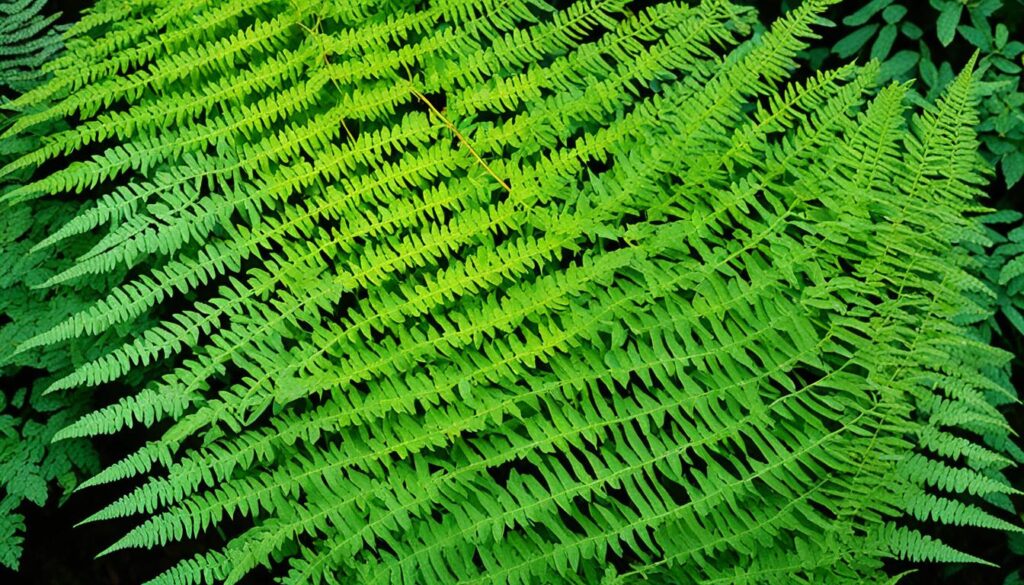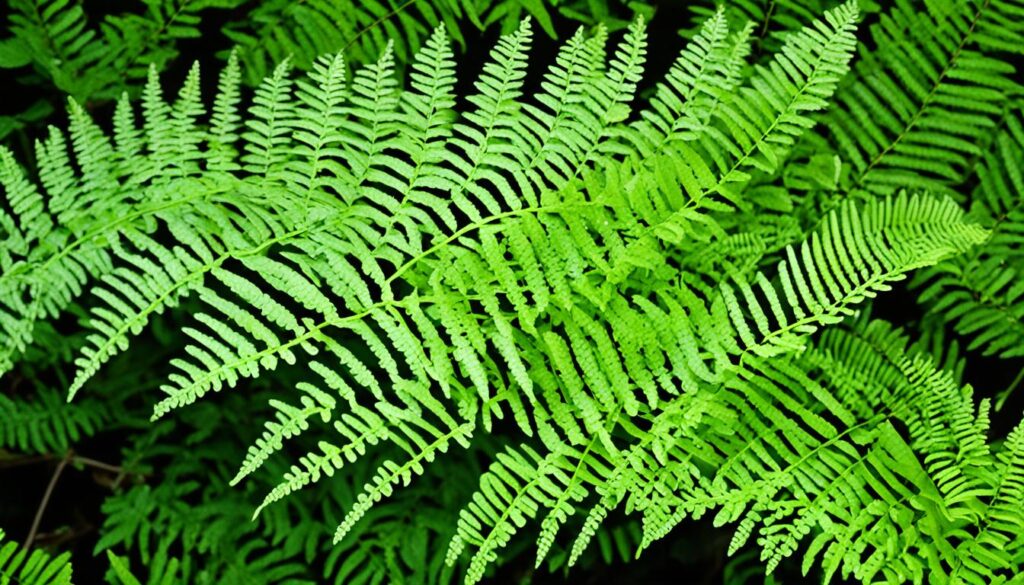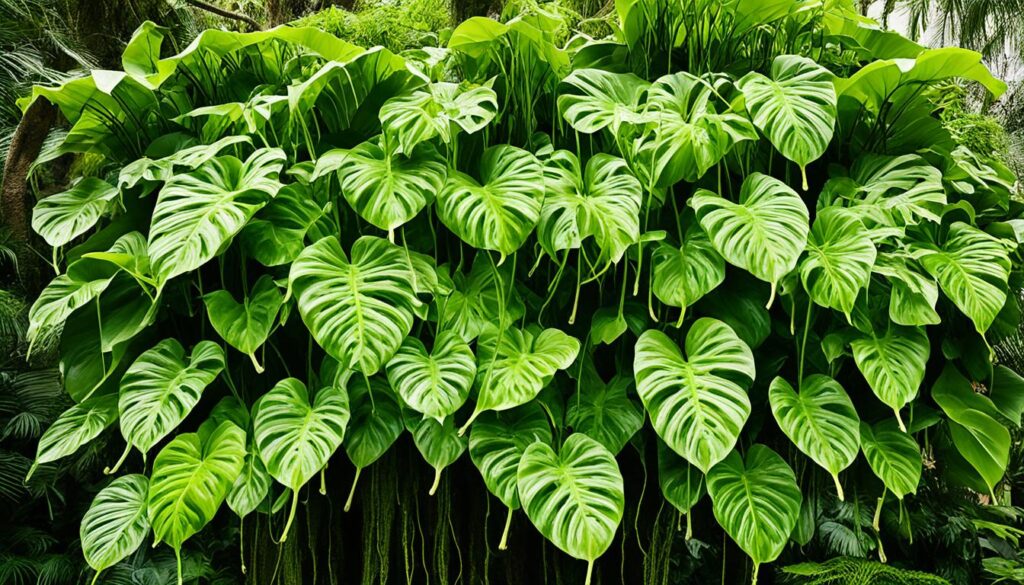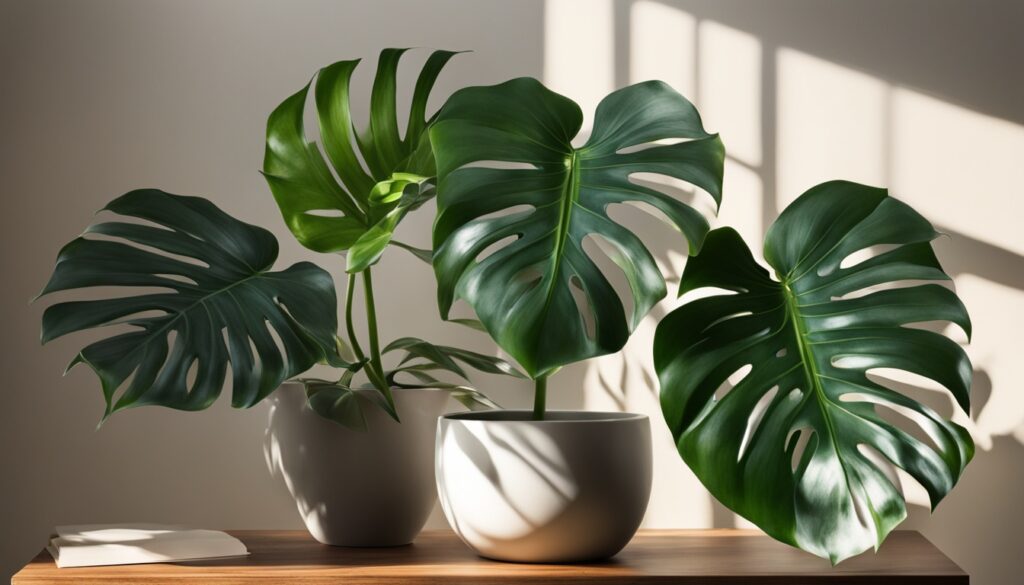Picture yourself in a lush, tropical greenhouse, filled with vines and fern-like plants. In this green world, a special plant catches your eye. It has leaves that look like the detailed fronds of a fern. This plant is called a bipennifolium, a fascinating plant loved by plant lovers all over the world.
At first, the bipennifoliate leaves might seem just for show. But they are much more important. These leaves, with their many divisions, play a big part in identifying and classifying plants. They are especially important in the Araceae family, which includes philodendrons.
Key Takeaways
- Bipennate leaves have a fern-like, divided structure with multiple levels of leaflets.
- Bipennate foliage is a key botanical feature used to identify and classify certain plant species.
- Understanding the terminology and anatomy of bipennate leaves is essential for plant enthusiasts and horticulturists.
- Bipennate leaves are a unique and captivating feature that add visual interest to indoor and outdoor gardens.
- Philodendron bipennifolium, also known as the Horse Head Philodendron, is a prime example of a plant with this distinctive leaf structure.
Introduction to bipennifolium
The word “bipennifolium” comes from Latin. It means “two feathers” and “leaf.” This refers to the special way some plants have leaves. These plants have leaves that split into two main parts, which helps in identifying them. This is especially true for plants in the Araceae family, like the popular philodendron genus.
Definition and Botanical Terminology
Bipennate leaves look like ferns because they split into two parts. This makes them “doubly pinnate” or “bipinnate.” These leaves are a key feature of plants in the bipennifolium group. They help us understand how these plants are related and how they evolved.
Significance in Plant Anatomy and Identification
The way bipennate leaves are structured is key to identifying plants, especially in the Araceae family. These leaves help experts tell apart different philodendron types and other aroid plants. Knowing about bipennifoliate leaves helps us learn more about plant diversity and how plants have adapted over time.
“The bipennate leaf structure is a testament to the remarkable diversity and adaptability of plant life, showcasing the intricate evolutionary strategies employed by species within the Araceae family.”
Characteristics of Bipennifoliate Leaves
The bipennifoliate leaves of some plants have a special design. They have a compound leaf structure, with the main leaf splitting into smaller parts. These parts form a beautiful fern-like foliage with a bipinnate fronds pattern.
Compound Leaf Structure
Bipennifoliate leaves look complex and highly divided. The main leaf is made up of many smaller leaflets. These leaflets can even have smaller leaflets of their own. This design makes the leaves look lush and feathery, which is unique in the plant world.
Fern-like Foliage and Bipinnate Fronds
The look of bipennifoliate leaves is similar to fern fronds. The leaflets are arranged in a bipinnate pattern along the leaf stalk. This makes them look like ferns, adding to their beauty and importance in botany.

“The bipennate leaf structure of certain plants is a remarkable adaptation, creating a visually stunning and botanically fascinating foliage display.”
Philodendron bipennifolium ‘Aurea’
The Philodendron bipennifolium ‘Aurea’ is a special type of Philodendron bipennifolium. It has beautiful lime green leaves. As it grows, its leaves change shape, turning from simple to lobed and looking like a horse’s head. This makes it known as the “Horsehead Philodendron”.
Unique Cultivar with Lime Green Leaves
This plant is loved for its unique look. New leaves start out in a bright, lime green color when it gets enough light. As they get older, the leaves turn a deeper, richer green. This adds beauty and contrast to the plant.
Leaf Shape Changes as Plant Matures
The Philodendron bipennifolium ‘Aurea’ is known for its changing leaf shape. At first, its leaves are simple and oval. But as it grows, the leaves get lobes and look like a horse’s head. This makes the plant stand out and look amazing.
“The Philodendron bipennifolium ‘Aurea’ is a true showstopper, with its striking lime green leaves and captivating leaf shape changes that captivate plant enthusiasts.”
What is a bipennifolium?
A bipennifolium is a plant with leaves that split into many parts. These parts split again into smaller parts. This makes the leaves look like ferns. It’s a key way to tell certain plants apart, especially in the Araceae family, which includes philodendrons.
The leaves of a bipennifolium are split in a special way. They have bipinnate fronds, with the main leaf splitting into smaller parts. This makes the leaves look like ferns. It’s a key feature for identifying these plants.
“The bipinnately compound leaves of a bipennifolium plant are a fascinating example of the diverse and complex leaf structures found in the natural world.”
Knowing about the bipennifoliate leaves is key to understanding the split-leaf philodendron and similar plants. It helps with their identification and care.

The leaves of a bipennifolium plant are very detailed and fern-like. They show how diverse and adaptable plants can be. By looking at their compound leaf structure, we can see the beauty and complexity of nature.
Care Requirements for Philodendron bipennifolium
The Philodendron bipennifolium, also known as the worry plant or parlor palm, needs special care to stay beautiful. It can live indoors for up to 30 years. This makes it a great choice for those who want a low-care yet beautiful plant.
Light Requirements
Philodendron bipennifolium, including the ‘Aurea’ type, loves bright, indirect light. This helps it grow well and keep its leaves big and beautiful. But, it’s important to keep it away from direct sunlight to prevent leaf scorch.
Watering Tips
Watering your Philodendron bipennifolium is all about keeping it moist but not too wet. Check the soil and water when it’s dry on top. Don’t overwater, as this can cause root rot.
Ideal Soil Mix
This plant does best in well-draining soil that’s not too dense. A mix of potting soil, perlite, and bark chips or orchid mix works great. It helps the plant get the nutrients it needs without getting waterlogged.
With the right care, including the right light, water, and soil, your Philodendron bipennifolium will grow well. You’ll enjoy its beautiful foliage and benefits like cleaner air and stress relief for many years.
“Philodendron bipennifolium is a stunning houseplant that can thrive indoors for decades with the right care. Its lush, bipinnate leaves and air-purifying properties make it a must-have for any indoor garden enthusiast.”
Climbing Habit of Bipennifoliate Plants
Many bipennifoliate plants, like Philodendron bipennifolium, love to climb. They grow best with a support, such as a moss pole or wood plank. This helps them grow into the beautiful, fern-like plants we love.
Promoting Mature Leaf Formation
As Philodendron bipennifolium gets older, its leaves change from simple to the complex, lobed shapes we adore. Giving it a moss pole to climb on triggers this change. It climbs up, just like in the rainforest, and grows the leaves we want.

“To encourage mature leaf growth in Philodendron bipennifolium, providing a moss pole for climbing mimics its natural growth habits, aiding in leaf development.”
Knowing how bipennifoliate plants climb and need support helps growers. This way, we can grow these beautiful plants and enjoy their unique look.
Varieties and Cultivars with Bipennifoliate Leaves
The Araceae family includes many species and cultivars with bipennifoliate leaves. The Philodendron bipennifolium ‘Aurea’ stands out with its bright lime green leaves. But there are many other plants in this family with similar, fern-like leaves.
The Monstera deliciosa, also known as the Swiss Cheese Plant, has leaves that look like they have holes and splits. The Rhaphidophora tetrasperma, or Mini Monstera, is smaller but has leaves that look similar.
- The Philodendron bipennifolium species comes from South America and has leaves that can be simple or shaped like a horse’s head.
- The Anthurium wendlingeri has leaves that look like ferns and are deeply divided.
- The Syngonium podophyllum, or Arrowhead Plant, has bipinnate leaves when it’s young, but they change to heart-shaped as it grows.
These plants show the beauty of bipennifoliate leaves. They can be the main attraction or part of a lush plant display. Plant lovers will find them fascinating.
“The Araceae family is a true treasure trove of botanical diversity, with countless plant varieties and cultivars showcasing the remarkable adaptability and visual appeal of bipennate foliage.”
Horticultural and Botanical Importance
Bipennifoliate leaves look like ferns and are very important in horticulture and botany. Scientists study their unique shape a lot. This helps us understand how plants grow and change over time.
These leaves are also loved for their beauty in gardens and indoor plants. They bring a natural elegance to any area. This makes them a favorite among gardeners and plant lovers.
Leaf Morphology Studies
Botanists and plant scientists find bipennate leaves fascinating. They study these leaves to learn about their evolution and how they work. This knowledge helps us understand plant diversity and how plants adapt.
Ornamental Value in Gardening
The fern-like look of bipennate leaves adds elegance to gardens and indoor spaces. These plants are popular for their beauty. They make a space look better and more interesting.

“The intricate and captivating leaf structures of bipennate plants have inspired generations of botanists and horticulturists alike.”
Identifying Bipennifoliate Plants
Identifying bipennifoliate plants, like the Philodendron bipennifolium, is exciting for plant lovers and experts. The unique compound leaf structure is a key way to spot these plants. Look for leaves with many, flowing leaflets that resemble fern-like foliage and bipinnate fronds.
The bipinnately compound leaf structure makes these plants stand out. This special leaf pattern, with its detailed divisions and a feather-like look, helps tell different species apart. It’s a big help for botanists, gardeners, and collectors trying to identify bipennifoliate plants.
If you love plants or are just starting, learning about bipennifoliate leaves can be eye-opening. Getting to know this unique leaf type helps you explore the wide world of bipennifoliate plants.
Cultural Significance and Traditional Uses
Bipennifoliate plants have a special place in many cultures. Their leaves look like ferns and have been valued for a long time. These plants have been celebrated for their unique look by people all over the world.
In some places, these plants are more than just pretty. They are important in medicine, art, and rituals. For example, some species are used in traditional medicine because of their healing powers.
The leaves of bipennifoliate plants also inspire art. In some communities, their patterns are used in art, textiles, and buildings. This shows how much these plants are appreciated.
“The distinctive foliage of bipennate plants has long captivated the human imagination, inspiring cultural traditions that celebrate the natural world.”
Everywhere, bipennifoliate plants have a special meaning and are used in different ways. They are found in many cultural practices and art forms. This shows how much people value these plants.

Propagation and Cultivation Tips
Bipennifoliate plants, like Philodendron bipennifolium, are easy to spread through different methods. You can use stem cuttings and divide the plant’s rhizomes to grow more of these special bipennifoliate plants.
To take stem cuttings, cut just below a node at a 45-degree angle. This helps roots grow better. Adding rooting hormone can also help the cutting grow stronger. After propagation, make sure it gets bright, indirect light and stays in a humid spot.
- Plant the cutting in soil that drains well and water when the top inch feels dry.
- When the roots are strong, move the plant to a bigger pot to help it grow bigger.
To grow Philodendron bipennifolium and other bipennifoliate plants well, give them the right light, water, and soil. These plants love bright, indirect light and soil that dries out a bit between waterings.
“To encourage the Philodendron bipennifolium ‘Aurea’ to produce mature leaves, consider providing a moss pole for climbing, replicating its natural growth habit.”
Knowing how to care for and spread these beautiful bipennifoliate plants lets gardeners enjoy their unique leaves indoors.
Toxicity Concerns and Pet Safety
Many bipennifoliate plants, like Philodendron bipennifolium, are harmful if pets or kids eat them. They have calcium oxalate crystals that can make pets uncomfortable if they eat them.
If pets eat Philodendron bipennifolium, they might feel a lot of pain, act agitated, and try to touch their face. They could drool, foam, cough, have trouble swallowing, and breathe hard. They might also have mouth pain, upset stomach, and even vomit. In the worst cases, they could have convulsions, coma, skin problems, and it could be deadly.
To keep your pets safe, be careful when you have these bipennifoliate plants at home. You can use barriers, hang plants high up, or teach your pets to “Leave it.” This helps keep them away from the plants.
“Safety precautions for dog owners include creating barriers between pets and the plant, using hanging planters or high shelves to keep plants out of reach, implementing training commands such as ‘Leave it,’ and proper identification of toxic plants to prevent emergencies.”
If you think your pet ate a bipennifoliate plant, act fast. Clean their mouth, give them foods high in calcium, and get vet help right away. Knowing the signs can help you act quickly if something happens.
Bipennifoliate plants make your home look nice, but keep your pets safe first. By being careful and knowing the risks, you can enjoy these plants. And still, keep your pets safe and healthy.

Conclusion
The bipennifolium is a plant with fern-like leaves that shows how diverse and complex nature can be. It’s especially interesting because of its bipennifoliate leaves. These plants, like the Philodendron bipennifolium, are important in both gardening and science. They attract both plant lovers and scientists.
Learning about bipennifoliate plants helps gardeners and scientists enjoy and care for these plants better. They learn about how these plants grow, their leaves, and how to take care of them. This knowledge is useful for understanding plant identification and the connections in nature.
As we keep exploring the plant world, the bipennifolium and its relatives will continue to amaze us. They show the beauty and complexity of plant anatomy and horticultural importance. These plants inspire us with their unique features.


